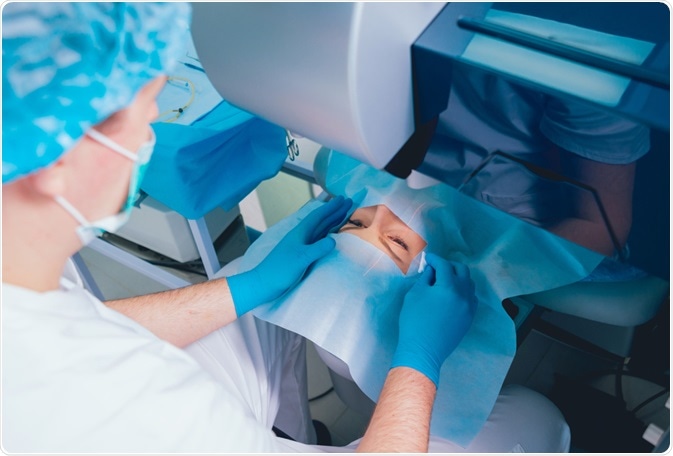LASIK (laser in situ keratomileusis) is a surgery that uses a laser to reshape the cornea of the eye. The procedure is performed in an outpatient surgical setting, with the patient reclining under a surgical device called an excimer laser. The general aim of the procedure is an improvement in the uncorrected visual acuity, thus everyday tasks in life can be performed without any optical aids.
 Image Credit: Roman Zaiets/Shutterstock.com
Image Credit: Roman Zaiets/Shutterstock.com
Patients who are unable to tolerate persistent eye dryness or engage in activities that bear a risk of eye trauma should avoid this procedure. Possible complications include flap dislocation, epithelial ingrowth, infections and tear dysfunction. Thus before undergoing a refractive procedure such as LASIK, risks and benefits should be carefully weighed.
Outcomes of the procedure
Safety of the LASIK procedure can be defined as the number and percentage of eyes that lose two or more lines of best spectacle-corrected visual acuity. Efficacy can be defined as the percentage of eyes with an uncorrected visual acuity of 20/20 or better.
Both efficacy and safety of LASIK have improved with experience and better equipment, and the recovery of optical quality usually occurs within one week (although for some people it may take up to 6 months). For low to moderate myopia, the safety of LASIK is in the range from 0 to 7% and its efficacy from 95 to 100%. For moderate to high myopia, the safety range is between 0 and 3.2% and efficacy between 55 and 94%.
As there is a tendency for regression to myopia, a significant number of patients require a second surgery to improve correction. Biological differences in wound healing responses are a major factor limiting the predictability of refractive surgery. Still, for patients with high degrees of myopia, even retreatment is often preferable to using thick eyeglasses.
High-contact sports increase the risk of flap dislodgement; hence such activities should be avoided. Because the procedure involves reshaping the cornea, the changes in its curvature affect night vision and can result in higher-order visual aberrations (glare, halos, ghosting and double vision).
Patients with presbyopia may still need reading glasses after LASIK, as myopia correction effectively increases the far-sightedness of presbyopia. Thus some patients may be candidates for monovision, where LASIK is done to allow one eye to see near and the other far – resulting in anisometropia. Older patients are more adjustable to anisometropia, which can eliminate or decrease the need for reading glasses.
LASIK Surgery and its Risks
Risk factors
The main risk factors that might influence whether LASIK is appropriate for certain patients are dry eye syndrome, keratoconus (eye disease that affects the structure of the cornea), large pupil size, thin cornea, high levels of refractive error, age and pregnancy.
That is the reason why the Food and Drug Administration (FDA) and the American Academy of Ophthalmology developed guidelines in order to easily separate good and bad candidates for LASIK. The main requirement is that candidates must be older than 18 years (except for children with one very myopic and one normal eye) and must have stable refraction for at least one year.
Moreover, pregnant or breastfeeding women should not undergo the procedure as these conditions can affect eye measurement. The same goes if the potential patient is taking certain prescription drugs (namely corticosteroids). Autoimmune disorders, immunodeficiency conditions, diabetes, herpes infections of the eye and other diseases are also significant risk factors.
Preoperative assessment for exclusion of risk factors comprises of slit-lamp examination, retinal evaluation and refraction, including measurement of astigmatism. Contact lenses must be discontinued before the preoperative evaluation in order to allow the stabilization of the cornea.
References
Further Reading